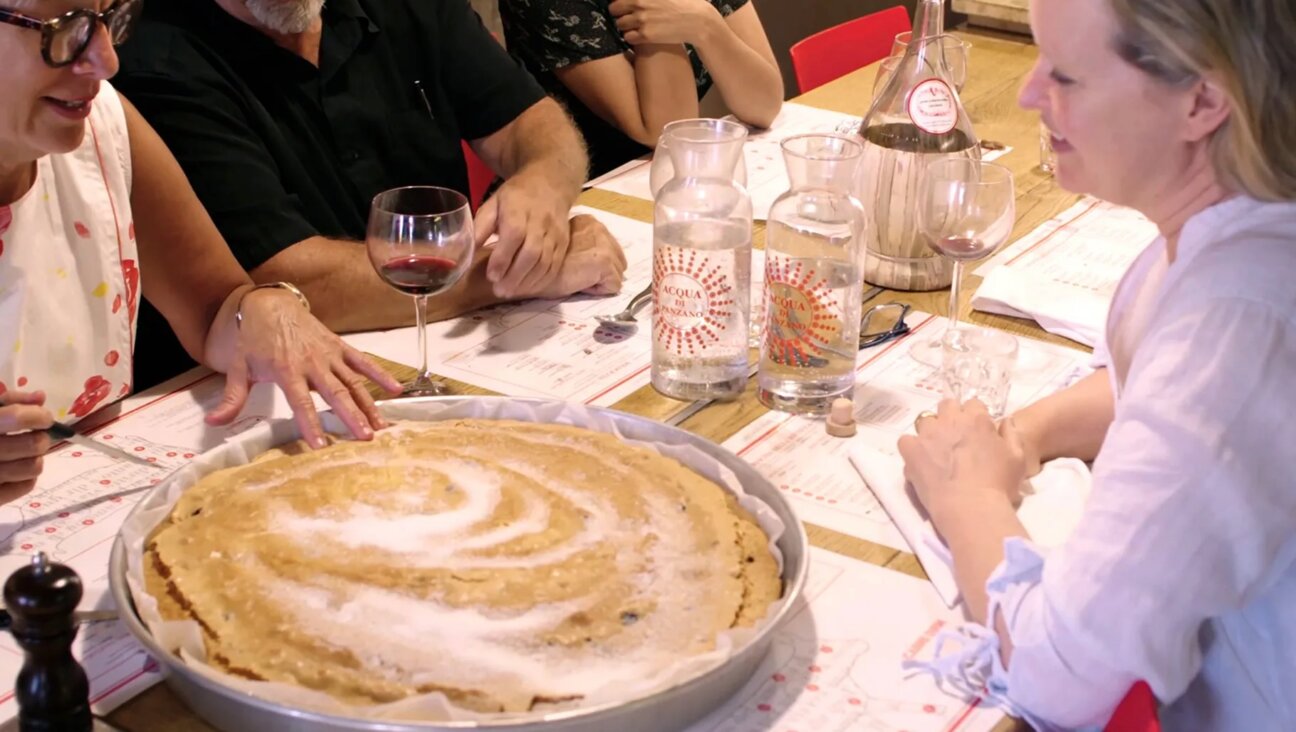Brilliant Za’atar Twists From Breads

Graphic by Angelie Zaslavsky
A savory babka? And why not? I got the idea to make a za’atar babka when I was making a za’atar-seasoned bread. To fill the babka, I use labne, which is ultra-rich strained yogurt that has a wonderfully creamy texture and tangy flavor — not unlike sour cream. Chiles, feta cheese and pine nuts add to the savory appeal. Here you take the babka dough and instead of twisting it and placing it in a loaf pan, you bake it free-form for individual twists or sticks. (You can follow the twist-shaping method for just about any of the babkas — some of the filling may ooze out onto the sheet pan, but those crispy bits are often the best.)
Makes 14 twists
3 tablespoons (30 grams) sesame seeds
1 recipe Basic Babka Dough (see below), chilled 24 hours
All-purpose flour for rolling and shaping
1 1/3 cup (400 grams) labne (see below)
1 finely chopped red jalapeño or Fresno chile (seeded for less heat)
1 tablespoon plus 1 teaspoon (20 grams) extra-virgin olive oil, plus extra for finishing
1 cup (110 grams) feta cheese, crumbled
½ cup (60 grams) pine nuts
1 cup (50 grams) fresh oregano leaves
2½ tablespoons (25 grams) za’atar (see below), plus extra for finishing
Egg Wash
1 large egg
1 tablespoon water
Pinch fine salt
1) Toast the sesame seeds: Place the sesame seeds in a small skillet over medium-high heat and toast them, shaking the pan often, until they are golden brown, 2–3 minutes. Transfer the seeds to a small plate and set aside.
2) Roll the cold babka dough: Unwrap the cold babka dough and set it on a lightly floured work surface. Roll the dough into a 12-by-28-inch rectangle (it should be just a little shy of ¼ inch thick) with a long side facing you. Pull and shape the corners into a rectangle.
3) Fill and roll the dough: Spread the labne over the dough in a thin, even layer. Sprinkle it with the jalapeño, olive oil, feta, toasted sesame seeds, pine nuts, oregano, and za’atar. Divide the dough in half horizontally so you now have two 6-by-28-inch pieces. Working from the long bottom edge of one of the pieces, roll the dough up into a tight cylinder, pushing back on the cylinder with each roll to make it even tighter. Lift the cylinder, holding one end in each hand, and gently stretch and pull to tighten it even more (it will stretch to about 35 inches long). Repeat with the second piece of dough.
4) Divide the dough into strips and make the twists: Use a bread knife to slice each cylinder in half lengthwise so you have 4 long pieces, and then slice those pieces crosswise into 7 equal sections (about 5 inches each) to make a total of 28 strips. Cross 2 equal-size pieces to create an X, keeping the exposed filling facing up. Twist the ends together like the threads on a screw so you have at least 1 twist on each side of the X (3 twists total). Repeat with the remaining pieces. Set 7 twists on one parchment paper–lined rimmed sheet pan and 7 twists on a second parchment paper–lined sheet pan.
5) Let the twists proof: Cover the sheet pans with plastic wrap and set aside in a warm, draft-free spot until the twists have doubled in volume and are very soft and jiggly to the touch, 2 to 3 hours, depending on how warm your room is.
6) Preheat the oven to 350° F (if you are letting the dough rise in the oven, as described in the Note on page 79, be sure to remove the sheet pans and bowl of water before preheating!).
7) Bake the twists: Make the egg wash by whisking the egg, water, and salt together in a small bowl. Brush egg wash over each twist, and bake until they are dark brown and baked through, about 20 minutes; check the twists after 15 minutes, and if they are getting too dark, tent them loosely with a piece of parchment paper. Remove the twists from the oven and, while they are still warm, brush with more olive oil and sprinkle with a little za’atar. Serve warm or at room temperature.
Basic Babka Dough
Makes about 2 pounds (900 grams) of dough, for two 9-by-5-inch babkas
This is the simpler of the two babka doughs — this dough will yield a very rich and delicious babka. And if you want an even richer, flakier version, try out the Advanced Babka Dough, which will produce a babka that tastes closer to the one we make at Breads Bakery. Making babka takes less than an hour of actual work — the rest of the time is the proofing and the baking. You can shape the cake into a twisted loaf, or bake it in smaller pieces in a muffin tin, or even try baking it free-form. The thing about babka is that even if it isn’t perfect in your eyes, when it comes out of the oven hot and fragrant, I guarantee that your friends and family will devour it.
½ teaspoon vanilla extract
½ cup (120 grams) whole milk (at room temperature)
2½ tablespoons (20 grams) fresh yeast or 2 teaspoons (6 grams) active dry yeast
2¼ cups (280 grams) all-purpose flour (sifted, 11.7%), plus extra for dusting and kneading
2 cups plus 2 tablespoons (220 grams )pastry or cake flour (sifted, 8.5 to 9%)
2 large eggs
1/3 cup (75 grams) granulated sugar
Large pinch fine salt
5 tablespoons plus 1 teaspoon (80 grams) unsalted butter (at room temperature)
1) Make the dough: Whisk the vanilla into the milk in the bowl of a stand mixer fitted with the dough hook. Use a fork or your fingers to lightly mix the yeast into the milk. Then, in this order, add the flours, eggs, sugar, salt, and finally the butter in small pinches.
2) Mix on the lowest speed, stopping the mixer to scrape down the sides and bottom of the bowl as needed, and to pull the dough off the hook as it accumulates there and break it apart so it mixes evenly, until the dough is well combined, about 2 minutes (it will not be smooth; see photo on page 29). If the dough is very dry, add more milk, 1 tablespoon at a time; if the dough looks wet, add more all-purpose flour, 1 table-spoon at a time, until the dough comes together. Increase the mixer speed to medium, and mix until the dough is smooth and has good elasticity, 4 minutes.
Related
3) Stretch and fold the dough: Lightly dust your work surface with flour and turn the dough out on top; lightly dust the top of the dough and the interior of a large bowl with flour. Grab the top portion of the dough and stretch it away from you, tearing the dough. Then fold it on top of the middle of the dough. Give the dough a quarter turn and repeat the stretch, tear, and fold. Continue to do this until you can stretch a small piece of dough very thin without it tearing, about 5 minutes. Then use your hands to push and pull the dough against the work surface and in a circular motion to create a nice round of dough. Set the ball in the floured bowl, cover the bowl with plastic wrap, and set it aside at room temperature for 30 minutes.
4) Chill the dough: Set the dough on a piece of plastic wrap and press it into a 1-inch-thick rectangle. Wrap the dough in plastic wrap and refrigerate it for at least 1 hour or up to 24 hours before proceeding with one of the recipes in this chapter.
Labne
Labne is a Lebanese strained yogurt into which salt and a little lemon juice are stirred to give the extra-thick yogurt a strong, tangy flavor. It’s an essential part of a Middle Eastern platter with olives, pita, and hummus or babaghanouj and perhaps Algerian Salad or Rinat’s Salad (both in the book) on the side. To make labne, you need a spot where you can let the yogurt drain over a bowl. Get creative and see what you come up with — a towel bar, shower rod, or even a broomstick or mop handle adjusted to shoulder-level height (with the gathered edges of the cheesecloth held down by weights or heavy books) works well. Or simply let the yogurt sit in a fine-mesh sieve placed over a deep bowl so it can drain.
Makes about 1 cup
2 heping cups (500 grams) plain full-fat yogurt (with a high fat percentage and a strong sour flavor)
1 heaping teaspoon fine salt
1 teaspoon fresh lemon juice
1) Whisk the yogurt, salt and lemon juice together in a bowl. Line a fine-mesh sieve with a large doubled layer of cheesecloth, letting the excess hang over the edges of the sieve (you want quite a bit of extra material so you can gather the ends easily). Pour the yogurt mixture into the cheesecloth and gather the ends, tying them together with a long piece of sturdy kitchen twine. Suspend the yogurt by tying the string to a rod set over the bowl. Remove the sieve and let the yogurt drain into the bowl at cool room temperature, out of the sunlight, for 24–36 hours.
2) Untie the string, place the cheesecloth with the drained yogurt in a sieve, and set the sieve and over a bowl. Refrigerate the labne for another 24 hours before using. The labne will keep in an airtight container in the refrigerator for 5 days to 1 week.
Za’atar
Za’atar can refer to either a spice blend made with sesame seeds, sumac, and salt or a wild herb that tastes like a combination of thyme, marjoram and mint. Za’atar the herb belongs to the oregano family and is a wild grass that is now protected by law in Israel. If you go to a spice shop, you might see many different combinations of spices and herbs labeled “za’atar.” Like garam masala or five-spice powder, every spice merchant and family has its own house blend — I like mine with fennel seed. The one must is that za’atar the blend should always include za’atar the herb.
Related
Excerpted from “Breaking Breads” by Uri Scheft (Artisan Books). Copyright © 2016. Photographs by Con Poulos.























